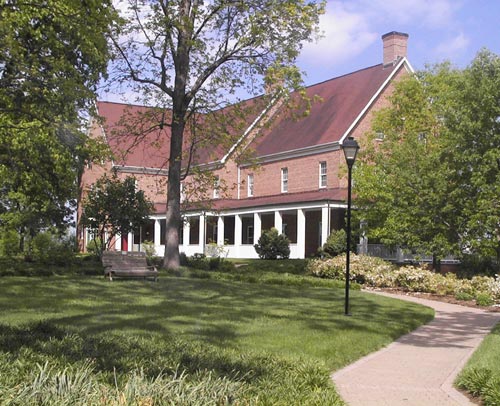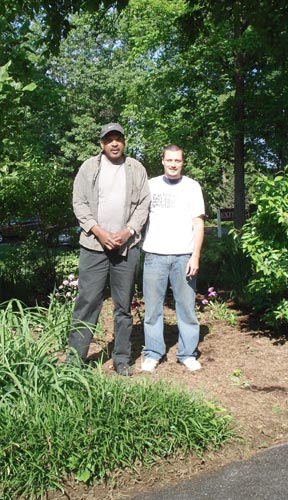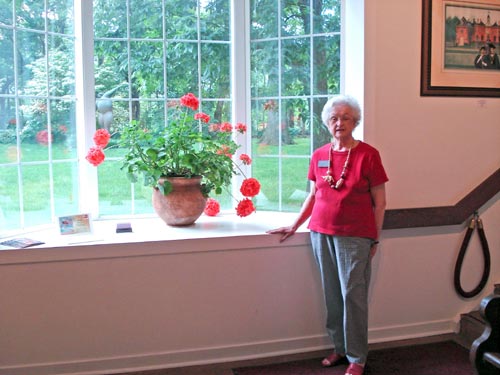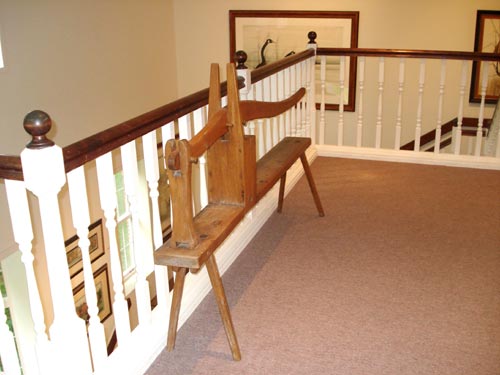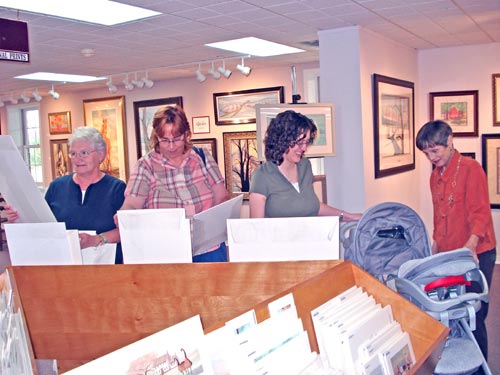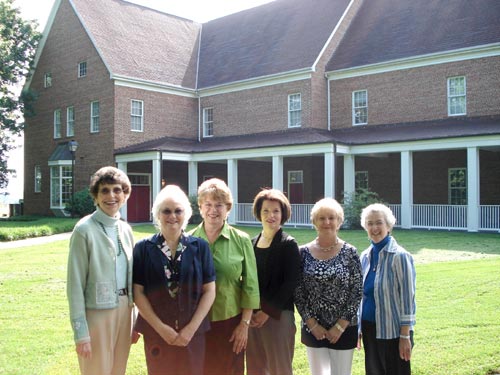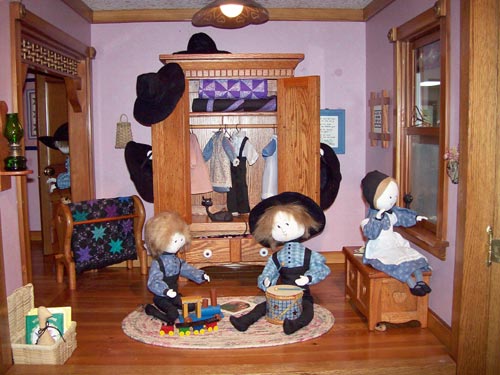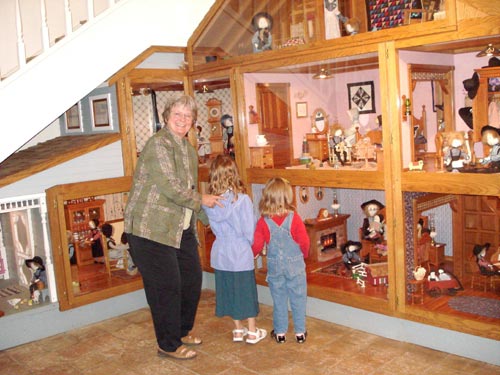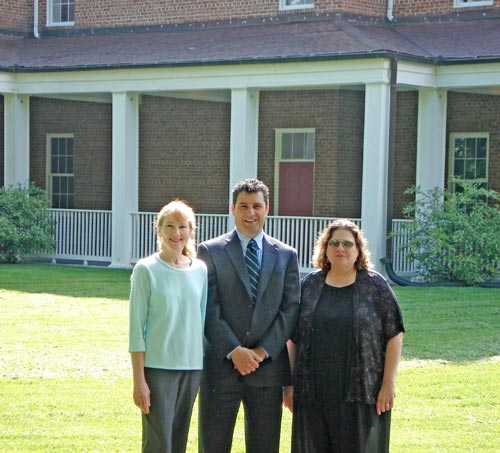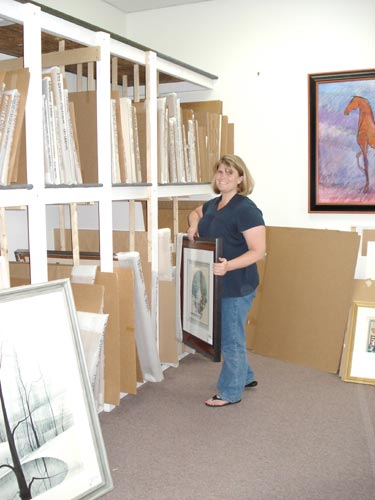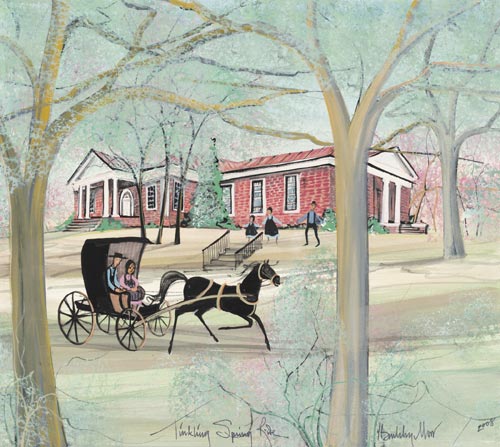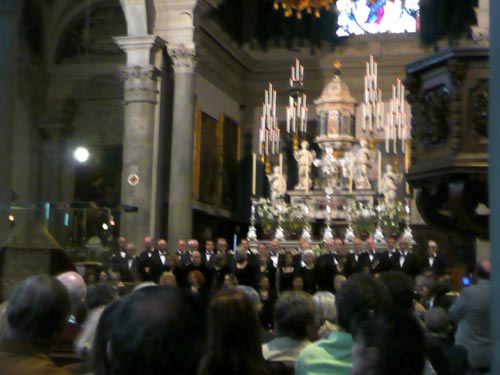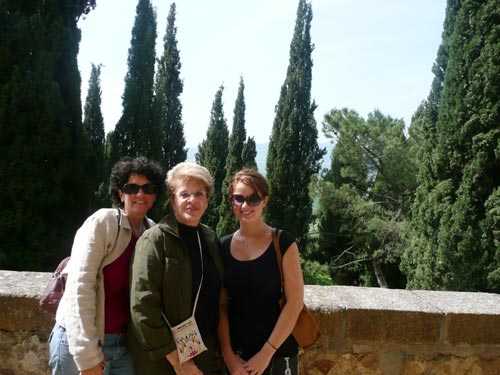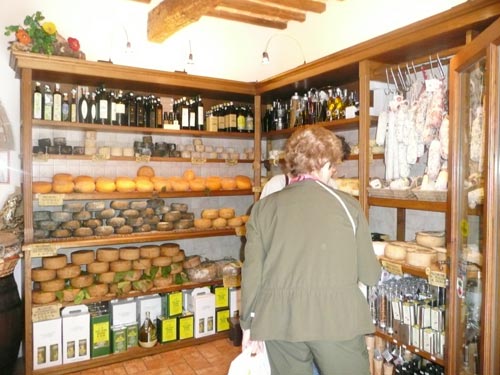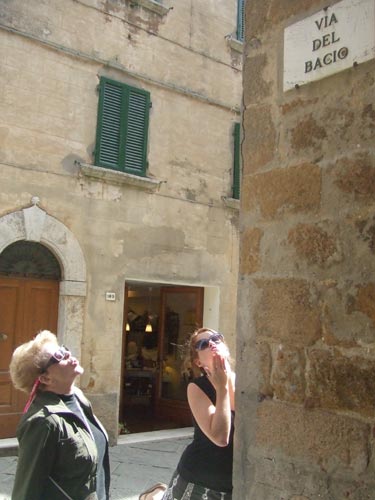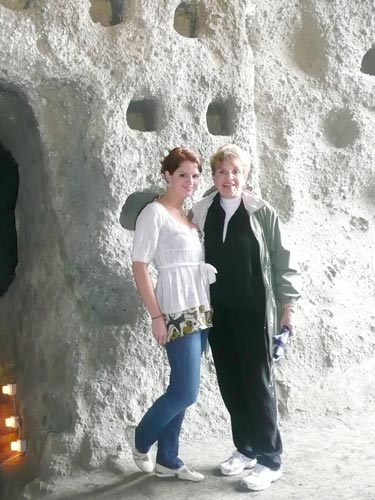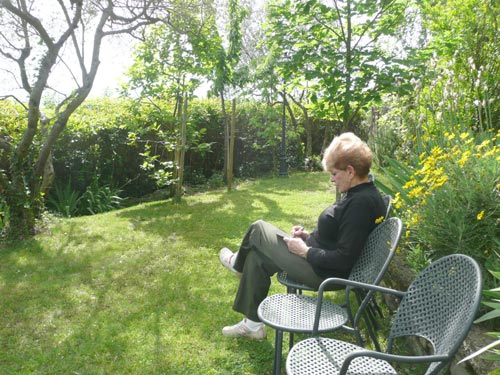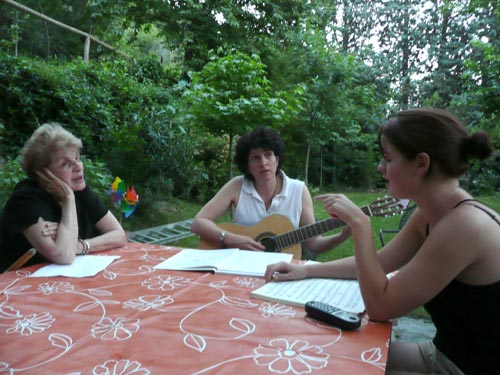Send this e-mail letter to a friend:
Dear Friends:
While I’m away in Italy, I thought it would be fun to introduce you to the staff at the P. Buckley Moss Museum and tell you a bit about what they do and about the Museum itself.
My museum is located at 150 P. Buckley Moss Drive in Waynesboro, VA, 22980. For more information and hours, please call 1-800-343-8643 or 540-949-6473; e-mail: mossmuseum@aol.com.
The Museum opened on May 12, 1989, with the stated purpose of permanently recording and illuminating my work through educational exhibitions, lectures, permanent collections, and archival files. Today, I’m very pleased that the Museum’s role in the Shenandoah Valley has expanded over the years to include other cultural, educational, and community programs. The Museum has hosted concerts and storytelling, holds an annual Easter Egg Hunt, and frequently hosts preschool and school-aged art programs. This September the Museum will participate in a regional celebration of the tradition of quilts and quilt making and will have a quilt display, a Quilting “B,” and two classes (September 13 and 20) for children aged 10-12 on creating an art quilt square. Many of the programs held at the Museum are sponsored by the P. Buckley Moss Foundation for Children’s Education.
The Museum’s founding director was Peter Rippe. There is a plaque dedicated to him that hangs just outside the entrance to the Museum. Peter was previously the director of the Roanoke Museum of Fine Arts and during that time gave me an important retrospective show that helped to draw attention to my work. I owe Peter a debt of gratitude; for his support of my work, for giving the Museum a firm foundation to build upon as its first director, and for his lasting friendship. When I think of Peter, I also remember my mother, known to many of you as “Gran Liz”. Peter and my mother made quite a team at the Museum. Peter would give tours up to a point and then call in my mother to tell stories. He was the straight man to her comedy. Occasionally, she would play the piano for visitors, with Peter standing beside her, and they would sing Danny Boy together.
I wanted the Museum to “fit” its surroundings, and I helped design it to look like an early 19th century house typical of early Shenandoah Valley architecture. The Museum has 18,000 square feet and three floors. It also has lovely grounds that include a Commemorative Walkway. I am very grateful to Jason Shea and James Carter, who keep the building and grounds looking so lovely and well-cared for. They are helped by J.P. Lockatell, a local high school student who works after school and during the summer. J.P. is a friend of my grandson Picco Gabellieri and a good worker.
James Carter, left, and Jason Shea, right, keep the Museum and its grounds in tip-top shape. Not pictured is J.P. Lockatell.
Visitors who enter the main floor are greeted by receptionists, sometimes called docents, who do a number of jobs, including answering and directing calls, giving tours, and watching the security monitors. Each person gives a unique tour, and they all make it interesting in their own special way. For example, Marianne Fickling and Penny Field are great at giving children’s tours, and we love to have them working whenever an area school schedules a field trip to the Museum.
The Museum’s wonderful receptionists, L. to R.: Pat Smith (who has been at the Museum the longest), Marianne Fickling, Carol Broderick (also a long-time staff member), Carol Simonton, Sharon Kirstein, and Barbara Hodgen. Not pictured are Penny Field (who has been at the Museum the second longest), Joan Gleeson, Betsy George, and Sandi Swartz.
Receptionist Joan Gleeson stands beside a glorious geranium that was brought in by Marianne Fickling, who has her own greenhouse. If you look carefully out the window, you can see Una Ballerina, the Museum’s conversation-piece sculpture.
The Museum has a wonderful gift shop on its bottom floor and maintains a current stock of my prints and collectibles. The retail staff, managed by Jo Cowherd, keeps the gift shop beautifully arranged and supplied.
On the main floor, and near the staircase that leads down to the gift shop, is an old apple press that was given to me by my friend J.B. Yount, III. It is a source of great amusement among the staff, because it is the 70-and-older “children” (usually older men) who can’t resist touching it and seeing how it works or worked. The youngsters leave it alone.
Retail Manager Jo Cowherd, far right, admires one of my youngest collectors.
The Museum’s excellent retail staff, L. to R.: Chris Ogden, Ginny Horn, Susie Whiting, Sharon Kirstein (who also works on the main floor as a receptionist), Jane Glenn, and Karen Mowen. Not pictured are retail manager Jo Cowherd and Nancy Martin.
No trip to the Museum would be complete without a visit to the dollhouse, which is located under the stairs just outside the gift shop. It was designed and built by Joe and Ellen Waterbury of Tama, Iowa, soon after the Museum opened. Joe and his wife Ellen have been collecting my art since the 1980’s and have become good friends. The dollhouse is a work of art in itself, with a miniature clock that keeps time and chimes each hour; handmade furniture designed to stay together with dowels and joints, no glue required; and miniature paintings that I added myself. Over the years, staff at the Museum have added their own personal touches, such as vegetables on the porch in the summer, pumpkins in the fall, and a tree at Christmas. Many visitors amuse themselves by finding and counting the glass and wooden mice hidden in nearly every room of the house. The exact number of mice in the house changes from day to day in case there are repeat visitors. Counting mice is entertaining for youngsters and the young at heart alike. Visitors who find all the mice are given a sticker that reads, “I counted all the mice in the P. Buckley Moss Dollhouse.”
Can you find the mice in this room? Hint: there are at least four.
Receptionist Betsy George shares the delights of the dollhouse with two young friends.
My eternal thanks go to my son-in-law Corrado Gabellieri, who is the director of the Museum, and his administrative team. Corrado overseas all the operations of the Museum, from maintenance and grounds-keeping to the pricing of originals. He is the “captain of the ship.” Corrado is a lifesaver in so many ways. In addition to his administrative responsibilities, he drives the truck (a really big moving van) to Collectors’ Conventions and helps with setup and has even framed my work for display when necessary. Bonnie Stump is the Museum’s curator, and she is responsible for cataloging and keeping track of my originals, among many other things. Bonnie creates the ads for the Museum, as well as the Barn Show invitations. Bonnie is very knowledgeable about my art and its symbolism and often speaks at Collectors’ Conventions and at the P. Buckley Moss Society’s Chapter Training. Bonnie and Corrado are assisted by Pat Carter, who helps with the paperwork that tracks the movement of my originals. My originals are often out on consignment with authorized dealers, and it takes someone like Pat, who is super-organized, to keep up with deadlines and to know where each piece is located and when it is needed someplace else. Paula Chernoff does the Museum’s scheduling, making sure that all positions are covered.
L. to R.: Pat Carter, Corrado Gabellieri, and Bonnie Stump. If you ever have any questions about the Museum or my art, they are the ones to call.
Receptionist Sandi Swartz often helps in the office. Here, she is filing originals. Dealers are constantly picking up and returning originals, so the shelves help keep them safe and up off the floor.
Receptionist Penny Field has been with the Museum since the beginning, second only to Pat Smith. In addition to Penny’s receptionist/tour guide duties, she helps to archive all the written material about me, including the many newspaper articles from all over the country.
The Museum holds quarterly Open Houses, also called “Barn Shows”. The Barn Shows are held in April, July (but sometimes June), October, and December and last three days (Friday through Sunday). The Barn is my studio and home in Waynesboro, Virginia, and is located a few miles from the Museum. During Barn Shows, I am at The Barn from 11:00 a.m. to 5:00 p.m. each day of the Open House to meet collectors and sign my work for them. I create a special print edition for the Museum to release during each Barn Show. My next Barn Show and Museum Open House will be held July 11-13, 2008, and we’ll release the print Tinkling Spring Ride.
Tinkling Spring Ride features Tinkling Spring Presbyterian Church in Augusta County, VA. The print will be released at the P. Buckley Moss Museum during its next Barn Show and Open House July 11-13. For more information, please contact the Museum at 1-800-343-8643.
Tinkling Spring Church was officially founded in 1740 by Scotch-Irish Presbyterians who settled in the area. The first meeting house was a log cabin that measured twenty-four by fifty feet. Interest in a new meeting house began in 1777 when the subscribers agreed to pay for the costs. However, the Revolutionary War delayed the construction, and it wasn’t until 1792 that a stone sanctuary was completed. The current church was erected in 1849 and remodeled in 1916.
I have been staying busy while in Italy and enjoying my time with my daughter Becky and her family and my oldest granddaughter Kate Donnelly. It’s been hot, by the way; 85 degrees! Please look below for pictures of our adventures.
Love,
Pat
Last weekend we went to the Duomo, or Cathedral, of Cortona to hear the Polyphonic Choir of Florence perform. Violins are my favorite instrument, and they were so beautiful in Handel’s Messiah, which was performed in English!
L. to R.: My daughter Becky Ghezzi, me, and my granddaughter Kate Donnelly. We were visiting Pienza, which is famous for its Pecorino cheese. Afterward we went to Montepulcciano, which is famous for its wine, for lunch.
So many delicious choices!
Kate and I blew kisses at the street sign for Via Del Bacio in Pienza. Via Del Bacio means “Street of the Kiss”.
We also visited Orvieto, which was built on a plateau above volcanic rock. Built into the rock under the city is a network of over 4,000 caves. We toured about twenty of them. The caves were used as bomb shelters in World War II. In this picture, Kate and I are standing in front of a cave wall that has had nesting holes for pigeons carved into it. In Roman times, the pigeons and their eggs were a food source for Orvieto’s inhabitants when it was under siege by barbarians.
I’ve been working, too. Here, I’m sitting in my garden working on an etching of an olive tree. The tree is to the left.
Becky, with the guitar; Kate; and I love to sit in the garden and talk and relax.
The Moss
Portfolio
74 Poplar Grove Lane
Mathews, VA 23109
(800) 430-1320
©P. Buckley Moss 2005
